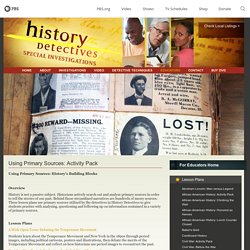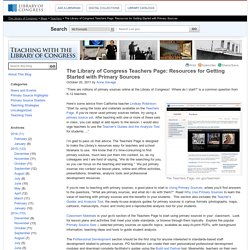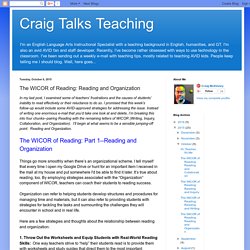

Analyzing Primary Sources: Reading Documents Video - Shmoop. Using Primary Sources: Activity Pack. Using Primary Sources: History’s Building Blocks Overview History is not a passive subject.

Historians actively search out and analyze primary sources in order to tell the stories of our past. Behind those streamlined narratives are hundreds of messy sources. These lesson plans use primary sources utilized by the detectives in History Detectives to give students practice with analyzing, questioning and following up on information contained in a variety of primary sources. Lesson Plans A Wide Open Town: Debating the Temperance Movement Students learn about the Temperance Movement and New York in the 1890s through period images, including political cartoons, posters and illustrations, then debate the merits of the Temperance Movement and reflect on how historians use period images to reconstruct the past.
Nazi Spy Ring Busted: Evaluating the Reliability of Primary Sources Students learn about Dr. Reading Like A Historian: Choosing Primary Source Documents. The Library of Congress Teachers Page: Resources for Getting Started with Primary Sources. “There are millions of primary sources online at the Library of Congress!

Where do I start?” Is a common question from K-12 teachers. The Teachers Page, loc.gov/teachers Here’s some advice from California teacher Lindsay Robinson: “Start by using the tools and materials available on the Teachers Page. If you’ve never used primary sources before, try using a primary source set. I’m glad to pass on that advice. If you’re new to teaching with primary sources, a good place to start is Using Primary Sources, where you’ll find answers to the questions, “What are primary sources, and what do I do with them?” Classroom Materials is your go-to section of the Teachers Page to start using primary sources in your classroom. The Professional Development section should be the first stop for anyone interested in standards-based staff development related to primary sources.
The Teachers Page has much more to offer, but here are a few ideas for getting started: Science. WICOR - Reading - CMS AVID. Today in History: February 12. Thomas Moran, Napoleon Sarony, photographer, circa 1890-96.

The Evolution of the Conservation Movement, 1850-1920 February 12 marks the birth of painter Thomas Moran (1837-1926).* His depictions of Western landscapes inspired Americans to conserve and cherish spectacular wilderness areas as part of their national heritage. In the summer of 1871, Moran joined the U.S. Geological Survey of the Territories. Headed by Ferdinand V. The Great Blue Spring of the Lower Geyser Basin, Yellowstone, chromolithograph of a painting by Thomas Moran, L.
Collaborating closely with William Henry Jackson, the expedition photographer, Moran took extensive notes and made numerous watercolor sketches of sulphur fields, hot springs, geysers, waterfalls, and evergreen mountain peaks. These images helped convince Congress to set aside the Yellowstone area as a national park. The Tower of Tower Falls, Yellowstone, chromolithograph of a painting by Thomas Moran, L.
Moran continued to travel and paint in the West. Hed reviewofliterature. Craig Talks Teaching: The WICOR of Reading: Reading and Organization. In my last post, I examined some of teachers’ frustrations and the causes of students’ inability to read effectively or their reluctance to do so.

I promised that this week’s follow-up would include some AVID-approved strategies for addressing the issue. Instead of writing one enormous e-mail that you’d take one look at and delete, I’m breaking this into four chunks--pairing Reading with the remaining letters of WICOR (Writing, Inquiry, Collaboration, and Organization). I’ll begin at what seems to be a sensible jumping-off point: Reading and Organization. The WICOR of Reading: Part 1--Reading and Organization Things go more smoothly when there’s an organizational scheme. Organization can refer to helping students develop structures and procedures for managing time and materials, but it can also refer to providing students with strategies for tackling the tasks and surmounting the challenges they will encounter in school and in real life. 1. 2. Context clues research - Buscar con Google. Free! 5 Types of Context Clues Poster.
▶ Context Clues Song (Context Clues by Melissa) - YouTube. Why Use Primary Sources? Primary sources provide a window into the past—unfiltered access to the record of artistic, social, scientific and political thought and achievement during the specific period under study, produced by people who lived during that period.

Bringing young people into close contact with these unique, often profoundly personal, documents and objects can give them a very real sense of what it was like to be alive during a long-past era. 1. Engage students Primary sources help students relate in a personal way to events of the past and promote a deeper understanding of history as a series of human events.Because primary sources are snippets of history, they encourage students to seek additional evidence through research.First-person accounts of events helps make them more real, fostering active reading and response. 2.
Many state standards support teaching with primary sources, which require students to be both critical and analytical as they read and examine documents and objects. 3. Top. SecondaryLP PrimarySecondarySources Web. History in the Raw - Learning with Primary Sources - Home.